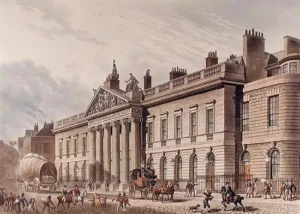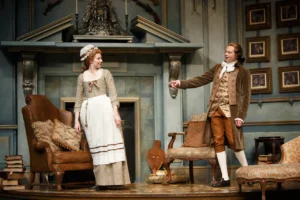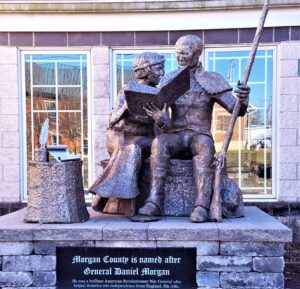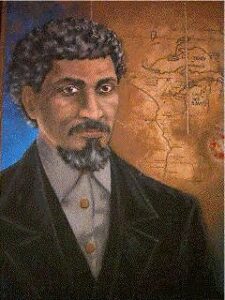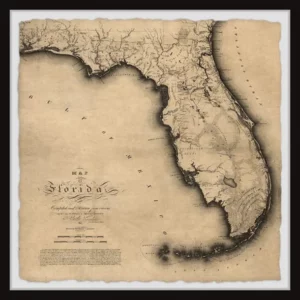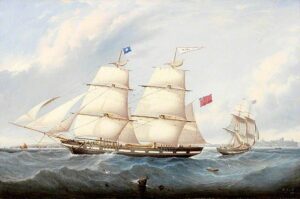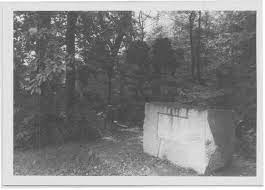Americanism Redux
March 30, on the journey to the American Founding, 250 years ago today, in 1773
Clip, clop. Horses on the street.
Click, clack. Shoes and walking sticks on the sidewalk.
Bustle and noise. Standing in front of the imposing building, top step of the stone stairs before you go inside. You’re in the shadows of six massive Roman-like pillars or columns, three of them to either side of you.
The place oozes power and position.
(Welcome to the EIC)
Today, 250 years ago, you’re on Leadenhall Street in east London, England, about to enter the headquarters of the East India Company, the EIC. Good luck getting anyone to stop and talk with you. Everyone is in a rush. Unless you’re connected somehow to the British Prime Minister, Lord North, or to a voting member of the House of Commons or House of Lords, or to the family or friends of King George III, no one wants to use their time today in hearing your thoughts and or ideas.
There are meetings all over this imperial city. A fear or sense of frenzy is in the air. For the past few months nearly thirty banks have closed across Europe, including England. A credit scare and a credit crisis took them down.
Will the pillars of the EIC crack next?
That’s what everyone wants to avoid. The EIC has a monopoly on the millions of acres in India, part of the British Empire. But the company teeters on bankruptcy. If it goes insolvent, Lord only knows the effect on the British economy, especially the people who work with money, finances, trade, and land values. Lord only knows.
So, we’re neck-deep in a gigantic economic problem—with both perceived and real aspects—that another era will call “too big to fail.”
What’s known today is that the Prime Minister, Parliamentary members, the Monarchy, and yes EIC officials will cut some sort of deal. You know it and I know it. Magically, they’ll find the money to infuse into the EIC with strings attached, cords attached, ropes attached. We won’t know the details just yet. They’ll be publicized soon enough. We just know it will happen.
You don’t need a powdered wig, knee britches, and brass buckle shoes to know how these deals go. They always go this way. So, either go inside the building or step aside.
For however long you’re in there, remember to feel the Roman pillars on your way out. And then, maybe it will be time to find a tavern and order an ale. While you drink, the deal is getting done.
Also
Elsewhere in London, the play “She Stoops To Conquer” is drawing crowds. The storyline is of a young man who thinks he’s marrying into a wealthy family only to discover they are anything but. It’s comedy with a message.
(She Stoops To Conquer)
There’s a real marriage in the deep woods near the Virginia-North Carolina border where husband Dan and wife Abigail celebrate the one-day anniversary of their wedding as the Morgans. It’s official for them after having been partners and parents together for several years. It’s not clear how the ten enslaved black people living with them see the situation. Will Dan and Abigail see eye-to-eye as co-enslavers? Does the vow change the vision? Will either spouse change the other and change the way they act toward the enslaved?
(The Morgans–she taught him to read and write)
Further west, it’s another newlywed couple. A black man named Jeanne Baptiste Pointe de Sable says yes in the vows to marry his new wife, Catherine. Jeanne is son of an enslaved Haitian woman. Catherine is from a local Native tribe. They’re excited to start a family—as the Morgans have already done—and they’re also optimistic that they can open a trading post along a river and a popular walking path for people, deer, and bison. Jeanne decides to name the land he’s acquired for the enterprise: it’s “Shikaakwa”, translated from Algonguin to mean “onion” and “striped skunk”, both tied by the thought of strong smell. A later era will hear the chosen place-name and mangle it a bit into “Chicago.” Jeanne and Catherine’s trading post is the first start-up business in the new community.
(Chicago’s founder)
Further, further west is Fray Diego Ximenez, a procurator in the province of Sonora, Mexico, New Spain. He’s part of what’s become a trend here of late—writing out his ideas for the better colonial, imperial administration of a place seized by a European power. In his case, his recommendations are raw and unvarnished: a better working relationship between the military and colonial officials is vital to success; military units are the backbone of distant control via local outlets; and Native people should be limited and quelled at every turn in their participation and visibility in imperial society.
(Diego Ximenez)
Two Virginians who’ve been involved in the push to assert colonial rights are doing other things today. A package is a day away from Thomas Jefferson’s plantation called Monticello in Virginia. Inside the package are cuttings of Green Gage Plums. Jefferson is eager to try the new type of fruit in his orchards.
(the plums Jefferson hopes to grow)
George Washington thinks through the wisdom of buying land in a place called Florida. He’s concerned about a British imperial law—the Proclamation of 1763—and its attempt to regulate land ownership west of the Appalachian Mountain chain. He’s studying how to use the law to his advantage in a Florida land deal.
(Where to buy?)
A thousand miles up the coast is the ship “Pachett”, sailing west toward New York City. On board the vessel is ship master Hugh Fallon. In his pocket is a document. On the document is legal phrasing that binds passenger James Mahoney to Fallon for a four-year term of servitude, a form of forced labor. Also on the document is the “mark” of Mahoney, who doesn’t know how to write—and thus can’t read—which could easily mean he has only the foggiest notion of what he’s agreed to. Fallon and Mahoney are New York-bound. Mahoney is depending on Fallon being an honest man.
The Pachett has crossed paths today with another ship headed in the opposite direction, toward England. On board is a booklet written by Samuel Mather of Boston. Mather has sent his writings to Benjamin Franklin in London. Mather’s booklet, entitled “An Attempt To Shew That America Must Be Known To The Ancients”, presents the theory that a thousand years ago Europeans were already here in the New World, courtesy of a global flood. Mather is making a claim to an American past of comparable length to the European one.
(latest Mather in a family determined to define American)
In Aberdeen, Maryland, Joseph Presbury looks forward, not backward. Today he finalizes a gift of one acre to be used in building one of the first Methodist churches in the colonies. He’s acting on the inspiration he felt in having been mentored recently by Robert Strawbridge, organizer of the first Methodists in the New World.
(the worship site)
These nine stories, 250 years ago today, span a range of life—relationships, ambitions, daily tasks, personal plans. In the day they occur, each seems a complete step in a bigger race. But in fact, each step is a closer move toward a new choice. Nothing stops, apart from the day that ends when the sun descends.
For You Now
Put an image in your mind—it’s the sun and the planets and various celestial bodies moving around it, toward it, passing beside it. That’s the image that struck me as I thought about the nine stories pivoting around the one story in the center. By “center” I’m referring to the emerging culmination of the EIC situation. By “nine” I’m referring to the three weddings (one fiction, two nonfiction), ship voyage, written report, written booklet, fruit tree cuttings, land speculation, and land donation
My bias up-front: my Redux series compels me to locate the EIC in the center. That’s a given. I’m guiding you through this series in order to understand how the fact of the British Empire affects the things coming into its orbit in real-time.
The nine stories are particles floating, drifting, shooting by, or orbiting and rotating around the center-sun. Another nine million such stories exist in the same form, motion, and placement. To me, the question is not just how they relate to the center-sun but, perhaps more importantly, how do they relate to each other. They may combine, collide, bump, or take on a spinning with each other. They may disappear, too. The center-sun will exert its own force as well on many of the particles. This will be especially true if the center-sun itself changes. It’s on a course to do so.
When that change occurs, when the center takes on a different shape and substance, the particles themselves will have the chance to imprint the central object. The imprint can be so strong that it alters the sun.
Suggestion
Consider the item, drawn from a national scale and perspective, that you choose to locate in the center-sun position as of today.
